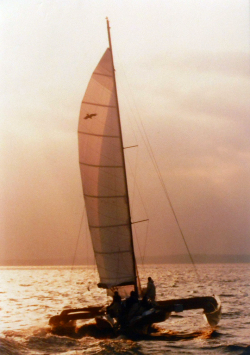Trimaran, Condor
40' x 28' x 3 Tons
18-Ft. Dia. Sea Anchor
Force 10 Conditions
File S/T-9, obtained from Phil Herting, Coconut Grove, FL. - Vessel name Triple Shock, hailing port Norfolk VA, trimaran designed by Condor Ltd., LOA 40' x Beam 28' x Draft 8' (20" board up) x 3 Tons - Sea anchor: 18-ft. Diameter Para-Tech on 400' x 5/8" nylon braid tether (no bridle) with 5/8" stainless steel swivel - Full trip line - Deployed in a gale in deep water about 120 miles west of Miami with winds of 50 knots and seas of 15-20 ft. - Vessel's bow yawed 45° (without bridle) - Drift was estimated to be 15 n.m. during 7 hours of deployment.
Triple Shock was on her way back to Miami from Jamaica, after participating in the Miami-Montego Race. The wind had been building for some time when the aluminum rudder cage split, leading to complete loss of steering control. The para-anchor was deployed to stabilize an emergency situation. No bridle was used, just a single rode leading off the main hull, as a result of which the bow would yaw considerably off the wind. With the weather deteriorating, a nearby Coast Guard vessel was asked to render assistance. Delivery skipper Phil Herting said that the seas were so large that the 110' CG cutter, Madagorda, would periodically disappear from view in the troughs. Transcript:
We were NNE of Great Issacs in deteriorating conditions when the aluminum fabricated rudder cage split. Upon breaking, the boat rounded up and then stalled. We immediately dropped the main and rolled up the balance of the jib. At that point we deployed the para-anchor. This device was utilized to stabilize an emergency situation and was deployed to ride out some bad weather. Because of the immediacy created out of the breakage we had to deploy it as fast as we could and with what line we had immediately available. For this reason the first line tied to the para-anchor was a 1/2" pre-stretched Dacron backup spinnaker halyard.
This immediately proved to be a mistake. The shock load transmitted back through the line was unbelievable. Realizing our mistake we then attached 250' of 3/4" three strand nylon. Though the nylon reduced the shock loading, it created another problem. I elected not to attach the second rode to a bridle because I wanted to save that for the tow from the CG cutter. So we led the rode through the bow chock to a primary winch. This enabled us to adjust the line when replacing chafing gear. And the chafe was the problem. Because the distance from the winch to the chock was so great, it created a longer spring and chafe area on the line. In retrospect, I should have deployed the nylon rode first and then had a Dacron tail. This would have minimized the chafe at the chock.
The Madagorda, the 110' cutter that came to our assistance, said that our rescue was done in the worst weather in which they had ever attempted one. They did a phenomenal job, though it did take 3 hours to get us a heaving line. One reason for this was the fact that the parachute was sitting right where they wanted to position themselves when getting us the towline.
What are you going to do? I hate to think of the situation if we had not had the para-anchor with us. It should be considered a vital piece of gear when making any substantial offshore passage.
Love the Drag Device Database? Help us to keep it free for all mariners by making a tiny donation to cover our server and maintenance costs. Thank You!
